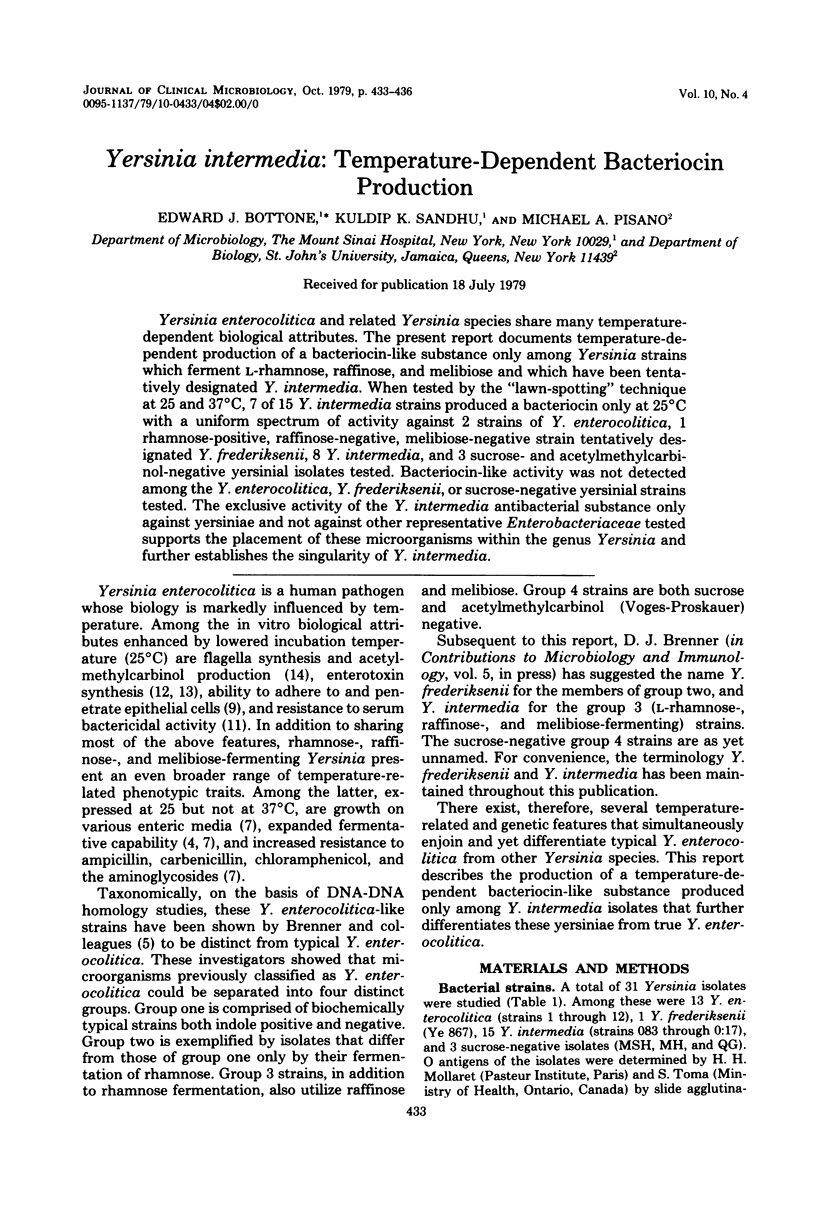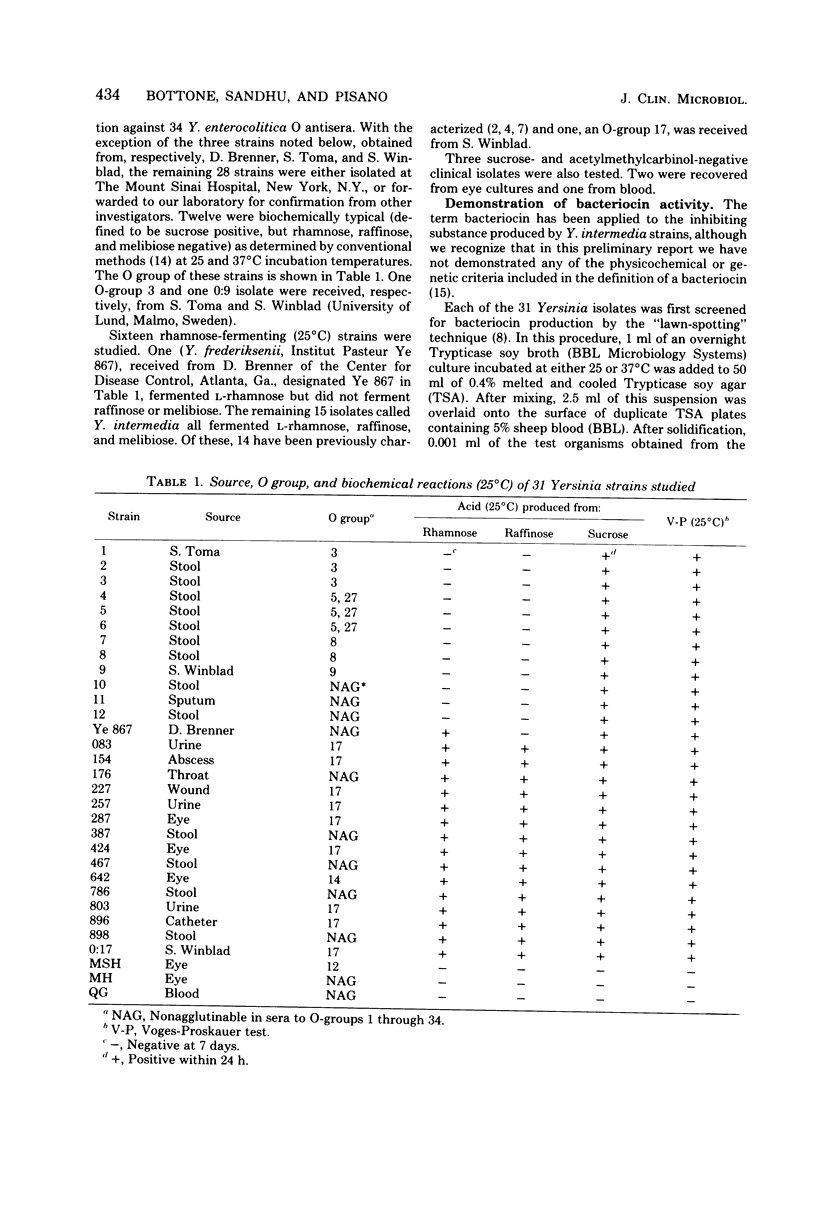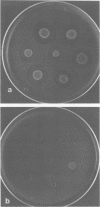Abstract
Yersinia enterocolitica and related Yersinia species share many temperature-dependent biological attributes. The present report documents temperature-dependent production of a bacteriocin-like substance only among Yersinia strains which ferment L-rhamnose, raffinose, and melibiose and which have been tentatively designed Y. intermedia. When tested by the "lawn-spotting" technique at 25 and 37 degrees C, 7 of 15 Y. intermedia strains produced a bacteriocin only at 25 degrees C with a uniform spectrum of activity against 2 strains of Y. enterocolitica, 1 rhamnose-positive, raffinose-negative, melibiose-negative strain tentatively designated Y. frederiksenii, 8 Y. intermedia, and 3 sucrose- and acetylmethylcarbinol-negative yersinial isolates tested. Bacteriocin-like activity was not detected among the Y. enterocolitica, Y. frederiksenii, or sucrose-negative yersinial strains tested. The exclusive activity of the Y. intermedia antibacterial substance only against yersiniae and not against other representative Enterobacteriaceae tested supports the placement of these microorganisms within the genus Yersinia and further establishes the singularity of Y. intermedia.
Full text
PDF



Images in this article
Selected References
These references are in PubMed. This may not be the complete list of references from this article.
- BEN-GURION R., HERTMAN I. Bacteriocin-like material produced by Pasteurella pestis. J Gen Microbiol. 1958 Oct;19(2):289–297. doi: 10.1099/00221287-19-2-289. [DOI] [PubMed] [Google Scholar]
- BRUBAKER R. R., SURGALLA M. J. Pesticins. I. Pesticinbacterium interrelationships, and environmental factors influencing activity. J Bacteriol. 1961 Dec;82:940–949. doi: 10.1128/jb.82.6.940-949.1961. [DOI] [PMC free article] [PubMed] [Google Scholar]
- Bottone E. J. Atypical Yersinia enterocolitica: clinical and epidemiological parameters. J Clin Microbiol. 1978 Jun;7(6):562–567. doi: 10.1128/jcm.7.6.562-567.1978. [DOI] [PMC free article] [PubMed] [Google Scholar]
- Bottone E. J., Chester B., Malowany M. S., Allerhand J. Unusual Yersinia enterocolitica isolates not associated with mesenteric lymphadenitis. Appl Microbiol. 1974 May;27(5):858–861. doi: 10.1128/am.27.5.858-861.1974. [DOI] [PMC free article] [PubMed] [Google Scholar]
- Bottone E. J. Yersinia enterocolitica: a panoramic view of a charismatic microorganism. CRC Crit Rev Microbiol. 1977;5(2):211–241. doi: 10.3109/10408417709102312. [DOI] [PubMed] [Google Scholar]
- Chester B., Stotzky G. Temperature-dependent cultural and biochemical characteristics of rhamnose-positive Yersinia enterocolitica. J Clin Microbiol. 1976 Feb;3(2):119–127. doi: 10.1128/jcm.3.2.119-127.1976. [DOI] [PMC free article] [PubMed] [Google Scholar]
- FREDERICQ P. Colicins. Annu Rev Microbiol. 1957;11:7–22. doi: 10.1146/annurev.mi.11.100157.000255. [DOI] [PubMed] [Google Scholar]
- Pai C. H., Mors V. Production of enterotoxin by Yersinia enterocolitica. Infect Immun. 1978 Mar;19(3):908–911. doi: 10.1128/iai.19.3.908-911.1978. [DOI] [PMC free article] [PubMed] [Google Scholar]
- Pai C. H., Mors V., Toma S. Prevalence of enterotoxigenicity in human and nonhuman isolates of Yersinia enterocolitica. Infect Immun. 1978 Nov;22(2):334–338. doi: 10.1128/iai.22.2.334-338.1978. [DOI] [PMC free article] [PubMed] [Google Scholar]
- Tagg J. R., Dajani A. S., Wannamaker L. W. Bacteriocins of gram-positive bacteria. Bacteriol Rev. 1976 Sep;40(3):722–756. doi: 10.1128/br.40.3.722-756.1976. [DOI] [PMC free article] [PubMed] [Google Scholar]



